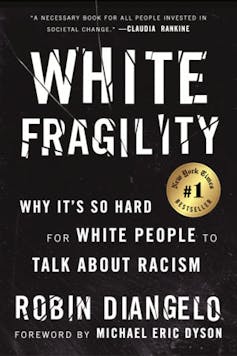About the author: Raluca Bejan is an Assistant Professor of Social Work at Dalhousie University.
Published by Beacon Press in 2018, White Fragility: Why it’s so Hard for White People to Talk About Race has now become a sensation in the wake of the protests after George Floyd’s death at the hands of police. The book’s success did not come by chance.

White Fragility’s author, Robin DiAngelo, has nurtured the concept since 2011, with a paper she published in the International Journal of Critical Pedagogy. A former education professor, DiAngelo left academia for the much more lucrative business of providing racial sensitivity training to those unable to grapple with the racial realities of their workplaces.
Despite grandiose claims of establishing a “sociology of dominance,” the book contains little thought-provoking material and makes several problematic assumptions.
Insider status
DiAngelo centres on what she identifies as the racism of the well-educated liberal elite, whom she perceives as enacting racism while maintaining a progressive, anti-racist stance. She then positions herself as an insider in this cultural milieu, using this vantage point somehow to both challenge racism and, along the way, build a career.
White fragility is a form of racial control that protects “white dominance,” which is why DiAngelo seems to be teaching others how to manage its toxic display. DiAngelo positions herself as the only one capable of understanding the racist meanings of socio-cultural interactions and the only one to make a teachable moment out of it.
Homogeneity over difference
First, DiAngelo takes whiteness to be homogeneous. Phrases like “white collective,” “white dynamic,” “white voice,” “white frame of reference,” “white worldview” and “white experience” are all used to suggest a certain racial sameness.
Seeing racialization as containing different identities while denying the fact that diversity also exists within whiteness, falsely suggests that all whiteness is to be treated equally. It is a similar stretch to suggest that whiteness makes one de facto entitled.
Consider the treatment of seasonal workers from Eastern Europe who have been labouring in Germany during the COVID-19 pandemic. Their stories of abuse have made the headlines. How reasonable is it to consider these workers entitled when they are not even extended basic human rights?
Capitalism and labour
Second, DiAngelo takes as racial markers factors that would be more fruitfully treated as aspects of systems that distribute advantages and disadvantages. She writes: “Whites produce and reinforce the dominant narratives of society, such as individualism and meritocracy.”
But there is no race that could possibly have individualism ingrained in its collective thinking. Rather, it is something learned through the socio-economic system. What would DiAngelo say about whites in the post-Soviet or the post-communist bloc? Clearly, individualism, a value closely related to capitalism, was not a feature of the former communist regimes.
The book also assumes that there is some kind of an unspoken agreement among whites to protect their societal advantages, that cuts across class and other group allegiances. But this is not universal. While race and class are closely connected in the United States, as evidenced by the fact that racialized people are over-represented in low-paid jobs, in the United Kingdom for example, southeastern European whites work in low-skilled occupations alongside racialized migrants. In Greece, these low-skilled positions are occupied by Albanians.
A U.S.-centred understanding of race
Regardless of whether one grows up in Germany, the U.S. or Albania, DiAngelo argues, any person is socialized in a racialized context. New immigrants, she states, although they might not feel white and have stronger ethnic attachments, will have a “white experience externally” as long as they pass as white. It is an astonishing display of arrogance to suggest that racial socialization does not differ by culture, ethnicity and nationality.
DiAngelo further illustrates her point with the example of a German woman who reiterated in a training session that she knew little about racism because she grew up in Germany. DiAngelo challenged the German woman to think about American films depicting African Americans and the messages she received in childhood about people from Africa. Despite the gross generalization of all Africans being the same and despite the hegemonic reasoning that American values permeate the world, could it just be that the woman in question has watched more German films, since she was not raised in the U.S.?
Such thinking disregards that other countries have their own national forms of structuring advantages and disadvantages: rural migrant workers versus urban dwellers in China, caste in India or class in South Korea, for example.
Racialist classifications
In arguing that white supremacy describes a socio-political system of domination based on racial categories, DiAngelo sees no issue with relying on this very same system of racial classification to draw her arguments.
Yet such racialist thinking is keeping white supremacy intact. What makes one white, for example? It is the biological “trace,” as the late sociologist Stuart Hall would say — skin colour in this case.
Arguing that race and whiteness are social constructs but taking skin colour as the marker to define race is not that different from the 19th-century biological racism that linked race not with the colour of one’s skin but with one’s blood type or the shape of one’s head.
The refusal to consider contextual differences within whiteness maintains a binary understanding of race. Whiteness is either idealized by the mainstream or scorned by critical race theorists, as historian Nell Irvin Painter and philosopher Cornel West have long argued. In both cases, whiteness is benchmarked as the standard of comparison vis-à-vis race.
Understanding differences within whiteness might open up possibilities to overcome essentialist thinking, alter the distribution of material effects associated with racial classifications, build solidarity and construct alternatives to profiting from diversity training.![]()
This article was first published on The Conversation, which features includes relevant and informed articles written by researchers and academics in their areas of expertise and edited by experienced journalists.
Dalhousie University is a founding partner of The Conversation Canada, an online media outlet providing independent, high-quality explanatory journalism. Originally established in Australia in 2011, it has had more than 85 commissioning editors and 30,000-plus academics register as contributors. A full list of articles written by Dalhousie academics can be found on the Conversation Canada website.

